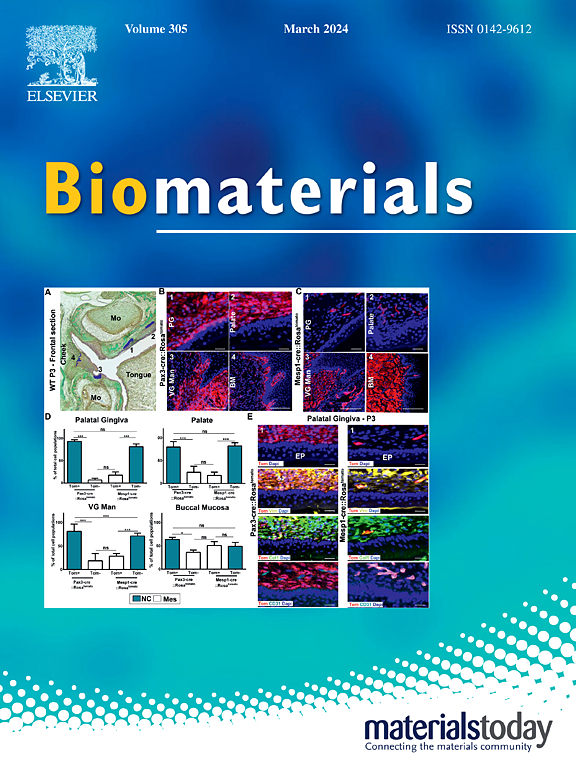A pH-responsive guanidino-based covalent organic framework nanodrugs for enhanced neuroprotection against subarachnoid hemorrhage by targeting NLRP3 inflammasome
IF 12.8
1区 医学
Q1 ENGINEERING, BIOMEDICAL
引用次数: 0
Abstract
Subarachnoid hemorrhage (SAH) represents a severe subtype of stroke, distinguished by its substantial mortality and morbidity rates. It initiates a series of harmful physiological responses, such as increased intracranial pressure, cerebral edema, and neuroinflammation. Pyroptosis, a form of cell death dependent on caspase-1, plays a crucial role in the inflammatory processes following SAH. Recent research indicated that the inhibition of the NLRP3 inflammasome is regarded as a promising therapeutic strategy for mitigating inflammatory responses. Bindarit, a β-blocker with anti-inflammatory properties, has demonstrated potential in mitigating NLRP3-mediated pyroptosis. Nevertheless, its clinical application is limited by its short half-life and inadequate penetration of the blood-brain barrier (BBB). To address these limitations, a novel pH-responsive erythrocyte membrane-biomimetic guanidino-based covalent organic framework (COF) nanocarrier, designated as B@COFDT-R, has been developed to encapsulate bindarit. This nanocarrier is specifically engineered to enhance drug delivery across the BBB and target the NLRP3/Caspase-1/GSDMD axis, thereby inhibiting neuronal pyroptosis in vitro and vivo. The development of B@COFDT-R constitutes a substantial advancement in the treatment of SAH. Through the enhancement of drug delivery mechanisms and the targeted modulation of critical inflammatory pathways, this nanocarrier holds the potential to significantly improve therapeutic outcomes for patients suffering from SAH.

一种ph反应性胍基共价有机框架纳米药物,通过靶向NLRP3炎性体增强对蛛网膜下腔出血的神经保护作用
蛛网膜下腔出血(SAH)是一种严重的脑卒中亚型,其特点是死亡率和发病率高。它引发了一系列有害的生理反应,如颅内压升高、脑水肿和神经炎症。焦亡是一种依赖caspase-1的细胞死亡形式,在SAH后的炎症过程中起着至关重要的作用。最近的研究表明,抑制NLRP3炎症小体被认为是减轻炎症反应的一种有希望的治疗策略。Bindarit是一种具有抗炎特性的β受体阻滞剂,已被证明具有减轻nlrp3介导的焦死的潜力。然而,其临床应用受到半衰期短和血脑屏障(BBB)渗透不足的限制。为了解决这些限制,一种新型的ph响应红细胞膜-仿生胍基共价有机框架(COF)纳米载体,命名为B@COFDT-R,已经被开发来封装宾达利特。这种纳米载体经过专门设计,可以增强药物在血脑屏障上的传递,并靶向NLRP3/Caspase-1/GSDMD轴,从而在体外和体内抑制神经元焦亡。B@COFDT-R的发展是SAH治疗的重大进步。通过增强药物传递机制和对关键炎症通路的靶向调节,这种纳米载体具有显著改善SAH患者治疗结果的潜力。
本文章由计算机程序翻译,如有差异,请以英文原文为准。
求助全文
约1分钟内获得全文
求助全文
来源期刊

Biomaterials
工程技术-材料科学:生物材料
CiteScore
26.00
自引率
2.90%
发文量
565
审稿时长
46 days
期刊介绍:
Biomaterials is an international journal covering the science and clinical application of biomaterials. A biomaterial is now defined as a substance that has been engineered to take a form which, alone or as part of a complex system, is used to direct, by control of interactions with components of living systems, the course of any therapeutic or diagnostic procedure. It is the aim of the journal to provide a peer-reviewed forum for the publication of original papers and authoritative review and opinion papers dealing with the most important issues facing the use of biomaterials in clinical practice. The scope of the journal covers the wide range of physical, biological and chemical sciences that underpin the design of biomaterials and the clinical disciplines in which they are used. These sciences include polymer synthesis and characterization, drug and gene vector design, the biology of the host response, immunology and toxicology and self assembly at the nanoscale. Clinical applications include the therapies of medical technology and regenerative medicine in all clinical disciplines, and diagnostic systems that reply on innovative contrast and sensing agents. The journal is relevant to areas such as cancer diagnosis and therapy, implantable devices, drug delivery systems, gene vectors, bionanotechnology and tissue engineering.
 求助内容:
求助内容: 应助结果提醒方式:
应助结果提醒方式:


